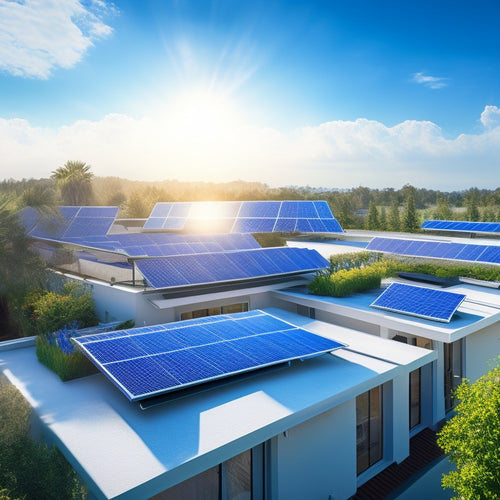
Most Energy Efficient Solar Panels for Optimal Energy Savings
Share
When it comes to maximizing energy savings, you want the most energy-efficient solar panels. Top brands like SunPower, Panasonic, and LG offer high-efficiency rates of 22.8%, 21.8%, and 20.5%, respectively, ideal for peak energy production. Monocrystalline Silicon and Bifacial Solar Panels boast superior energy conversion rates of 20-22%. Higher energy conversion efficiency rates lead to shorter energy payback periods, and high grid compatibility guarantees seamless integration. By understanding these factors, you can make an informed decision. Now, investigate the subtleties of solar panel efficiency and uncover how to enhance your energy savings even further.
Key Takeaways
- Top energy-efficient brands like SunPower, Panasonic, and LG offer high-efficiency rates, ideal for maximum energy production and long-term savings.
- Monocrystalline Silicon solar panels achieve superior energy conversion rates with 20-22% efficiency, making them a popular choice for optimal energy savings.
- Higher energy conversion efficiency rates lead to shorter energy payback periods, ensuring significant long-term savings and a faster return on investment.
- Assessing sunlight exposure is crucial for maximizing energy production, and selecting panels based on location's peak sun hours rating can significantly impact energy output.
- Evaluating warranty coverage options, guaranteed degradation rates, and durability factors can enhance confidence in solar panel performance and long-term energy savings.
Top Energy Efficient Brands
When it comes to utilizing the power of the sun, not all solar panels are created equal. You're likely aware that investing in energy-efficient solar panels is vital for ideal energy savings. That's why understanding the top energy-efficient brands is significant.
Brand comparisons reveal that market leaders like SunPower, Panasonic, and LG offer high-efficiency solar panels with impressive power output. These brands have set the bar high, driving market trends towards more efficient and durable products.
SunPower, for instance, boasts an impressive 22.8% efficiency rate, making it an attractive option for homeowners seeking maximum energy production. Panasonic follows closely, offering a 21.8% efficiency rate. LG, on the other hand, focuses on innovative designs and high-performance cells, resulting in an efficiency rate of 20.5%.
When selecting a brand, consider factors like warranty, durability, and cost. While top-tier brands may come with a higher price tag, their superior performance and longer lifespan can lead to significant long-term savings.
High Efficiency Solar Panel Types
As you investigate deeper into the world of energy-efficient solar panels, understanding the different types of high-efficiency solar panels becomes essential. You'll find that various solar panel materials and installation techniques contribute to their high efficiency. Let's examine the specifics.
| Type | Efficiency Range | Description |
|---|---|---|
| Monocrystalline Silicon | 20-22% | High-purity silicon crystals provide superior energy conversion rates |
| Polycrystalline Silicon | 15-18% | Multiple crystals are combined, offering a more affordable option with slightly lower efficiency |
| Bifacial Solar Panels | 18-22% | Dual-sided panels capture light from both sides, increasing energy output |
| Thin-Film Solar Cells | 7-14% | A cost-effective option with lower efficiency, but more flexible installation options |
You'll notice that each type has its strengths and weaknesses. Monocrystalline silicon panels offer the highest efficiency, but at a higher cost. Polycrystalline silicon panels provide a more affordable option, while bifacial solar panels offer increased energy output. Thin-film solar cells, on the other hand, are more adaptable regarding installation techniques. Understanding these differences will help you make an informed decision when selecting the most energy-efficient solar panels for your needs.
Maximum Power Output Ratings
When selecting energy efficient solar panels, you'll want to pay attention to the maximum power output ratings, which are influenced by high-efficiency cell technology that minimizes energy loss.
You'll also need to take into account the peak sun hours rating, which measures the panel's ability to generate power under various sunlight conditions.
Additionally, look for a module efficiency guarantee, which guarantees the panel will maintain a certain level of performance over its lifetime.
High-Efficiency Cell Technology
Frequently, solar panels with high-efficiency cell technology outperform their conventional counterparts, thanks to their ability to convert a larger percentage of sunlight into electrical energy.
As you consider investing in solar panels, it's crucial to understand the significance of high-efficiency cell technology in maximizing your energy savings.
When you opt for high-efficiency solar panels, you can expect:
-
Improved cell performance: High-efficiency cells are designed to minimize energy losses, resulting in more power output per unit area.
-
Technology advancements: Manufacturers continually develop new techniques to enhance cell efficiency, ensuring you benefit from the latest innovations.
-
Increased energy yield: By converting more sunlight into electricity, high-efficiency solar panels can generate more power per hour of sunlight.
Peak Sun Hours Rating
Your solar panel's maximum power output is directly tied to the amount of peak sun hours it receives. Peak sun hours (PSH) refer to the amount of energy your solar panel receives from the sun during a specific period. The more PSH your panel receives, the higher its maximum power output will be.
To enhance solar performance, it's crucial to assess your location's sunlight exposure. A sunlight exposure analysis will help you determine the average daily PSH your panel will receive.
When selecting a solar panel, look for the peak sun hours rating, usually denoted as PSH/Day. This rating indicates the panel's maximum power output under ideal sunlight conditions. A higher PSH rating means your panel will produce more energy, even on cloudy days.
For ideal energy savings, consider a solar panel with a high PSH rating, especially if you live in an area with limited sunlight. By choosing a panel that matches your location's sunlight exposure, you'll maximize your energy savings and enjoy a faster return on investment.
Module Efficiency Guarantee
Typically, solar panels come with a module efficiency guarantee, which outlines the maximum power output rating under standard test conditions. This guarantee assures you get the most out of your solar panel system.
As you investigate different solar panel options, you'll want to pay attention to the module efficiency guarantee, as it directly impacts your energy savings.
When evaluating module efficiency guarantees, consider the following key aspects:
-
Warranty coverage options: Look for manufacturers that offer extensive warranty coverage, including performance guarantees that protect your investment.
-
Module performance metrics: Understand the metrics used to measure module performance, such as maximum power output, efficiency, and temperature coefficients.
-
Degradation rates: Check the guaranteed degradation rates, which indicate how much the panel's performance will decrease over time.
Energy Conversion Efficiency Rates
With the increasing demand for renewable energy, the focus has shifted to enhancing energy conversion efficiency rates in solar panels. You want to guarantee that your solar panels can convert sunlight into usable energy with maximum effectiveness. A higher energy conversion efficiency rate translates to a shorter energy payback period, reducing your environmental impact.
When selecting solar panels, consider installation considerations, such as the amount of shade your roof receives, to maximize energy production. Maintenance requirements, including cleaning and inspecting your panels, also play an essential role in maintaining peak efficiency.
Look for solar panels with high grid compatibility, assuring a seamless integration with your existing electrical infrastructure. Additionally, take advantage of government incentives and financing options to make your solar panel investment more affordable.
With performance monitoring and solar tracking, you can enhance your energy production and store excess energy for later use. By prioritizing energy conversion efficiency rates, you can reap the benefits of renewable energy while minimizing your environmental footprint.
Durability and Longevity Factors
Most solar panels are designed to last for at least 25 years, and some manufacturers even offer warranties that extend up to 40 years.
When considering durability and longevity factors, you want to guarantee your solar panels can withstand various environmental conditions and maintain their performance over time.
To achieve this, look for solar panels with the following key features:
-
Weather resistance: A durable panel should be able to resist extreme weather conditions, such as heavy rainfall, hail, and high winds.
-
Temperature tolerance: Since temperature affects panel efficiency, a good panel should be able to operate efficiently in a wide temperature range.
-
Low maintenance requirements: A well-designed panel should be easy to clean and maintain, with minimal risk of damage or degradation.
Additionally, consider the aesthetic appeal of the panels, as well as installation considerations, such as the type of mounting system and the panel's weight.
Finally, think about the environmental impact of the panel's production and disposal.
Cost-Effective Solar Panel Options
Nearly 90% of homeowners prioritize cost-effectiveness when selecting solar panels, and rightly so. As you investigate options for your home, you'll want to evaluate budget-friendly alternatives that meet your energy needs without breaking the bank.
When assessing cost-effective solar panel options, you'll need to look beyond the panel's sticker price and examine installation cost considerations.
One key factor to evaluate is the cost per watt. Panels with a lower cost per watt may be a more affordable option, but be sure to also assess their efficiency and durability.
Additionally, look for manufacturers that offer discounts or promotions, which can help reduce the upfront cost. You may also want to investigate financing options or government incentives that can help offset the cost of installation.
When comparing different options, be sure to calculate the levelized cost of energy (LCOE), which takes into account the total cost of ownership over the panel's lifespan.
Ideal Solar Panel Wattage Ranges
Your solar panel system's wattage directly impacts its energy production and overall cost-effectiveness. When selecting the ideal solar panel wattage range, it's crucial to take into account your energy needs assessment to guarantee you're generating enough power to meet your requirements.
To determine the best wattage range for your solar panel system, take into account the following factors:
-
Energy consumption: Calculate your daily energy usage in watt-hours (Wh) to determine the required solar panel capacity.
-
Roof size and space: Assess the available roof area to determine the maximum number of solar panels that can be installed.
-
Local solar irradiance: Evaluate the amount of sunlight your location receives to determine the required wattage to meet your energy needs.
Innovative Energy Harvesting Features
Some solar panels come equipped with innovative energy harvesting features that greatly enhance their efficiency.
You'll benefit from solar tracking systems that adjust to the sun's movement, maximizing energy production. Energy storage solutions, like batteries, allow you to store excess energy for later use, reducing your reliance on the grid.
Modular designs enable easy installation and scalability, while micro inverters technology optimizes energy output at the individual panel level. Building integrated photovoltaics seamlessly integrate solar panels into your building's design, increasing energy independence.
Advanced photovoltaic innovations, such as bifacial panels, capture energy from both sides of the panel, enhancing output. Sustainable materials used in manufacturing reduce environmental impact.
Smart grid integration enables you to sell excess energy back to the grid, offsetting your energy costs. Additionally, energy management systems provide real-time monitoring and control, helping you optimize your energy usage.
With off-grid capabilities, you can enjoy energy independence, even in remote areas. By incorporating these state-of-the-art features, you'll reveal the full potential of your solar panels, utilizing the power of the sun like never before.
Certifications and Compliance Standards
How can you be certain that your solar panels meet the required standards for safety, quality, and environmental sustainability? Look for certifications from reputable bodies, which verify that your solar panels comply with regulations and testing standards.
-
UL Certification: This certification verifies that your solar panels meet the safety standards set by Underwriters Laboratories, a leading independent safety science company.
-
IEC Certification: The International Electrotechnical Commission (IEC) certification guarantees that your solar panels meet the required standards for performance, safety, and environmental sustainability.
-
ISO Certification: The International Organization for Standardization (ISO) certification verifies that your solar panels meet the required standards for quality management, environmental management, and occupational health and safety.
These certifications guarantee that your solar panels have undergone rigorous testing and meet the required standards for safety, quality, and environmental sustainability.
Frequently Asked Questions
Do Energy-Efficient Solar Panels Work Better in Cold Climates?
You'll find that energy-efficient solar panels actually perform better in cold climates, as lower temperatures increase their energy efficiency benefits, allowing you to capture more power from the same amount of sunlight.
Can I Install Solar Panels on a Metal Roof?
You can install solar panels on a metal roof, but consider specific installation considerations, such as ensuring a watertight seal and using compatible mounting systems; metal roof advantages include durability and ease of cleaning, making it an ideal surface for solar integration.
Are Energy-Efficient Solar Panels More Prone to Damage?
You might be surprised to know that 80% of solar panels last up to 30 years or more! When it comes to energy-efficient solar panels, you'll find that increased panel durability often involves efficiency trade-offs, making them no more prone to damage than standard panels.
Can I Mix and Match Different Solar Panel Brands?
You can mix and match different solar panel brands, but verify compatibility by checking voltage, current, and connector types; comparing brand performance helps you optimize energy output and warranties, but may impact system efficiency and support.
Do Solar Panels Generate Energy During a Power Outage?
You're wondering if solar panels generate energy during a power outage. Without grid independence, they won't produce power; however, with battery storage, you'll have a reliable energy source, ensuring your home stays powered even when the grid goes down.
Conclusion
As you begin your solar quest, remember that every watt counts. With the most energy-efficient solar panels, you'll be utilizing the power of the sun like a maestro conducts an orchestra. Efficiency is key, and with the right panels, you'll be dancing to the rhythm of ideal energy savings. So, align your solar arrangement with the top brands, high-efficiency types, and innovative features, and let the harmonious hum of energy savings echo throughout your home.
Related Posts
-

What You Need to Know About Permits and Inspections
You need to navigate the complex landscape of permits and inspections to guarantee your project complies with local z...
-

What Are the Average Cost Savings of Solar Panels
You can expect to save between $400 and $1,000 per year on your electricity bills with solar panels, which translates...
-

Best Solar Panel Options for Maximum Energy Savings
You can maximize your energy savings with solar panels that boast efficiency ratings above 20%, paired with extensive...


